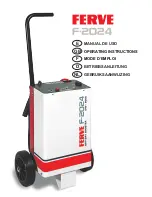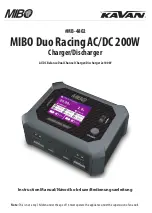
Prime Series
13 of 20
User’s Manual
11. PROPER CARE OF DEEP-CYCLE LEAD-ACID MOTIVE POWER BATTERIES
Motive power battery packs are subjected to severe deep-cycle duty on a daily basis. Although these
batteries are designed to withstand such duty, the following precautions must be observed to obtain good
performance and maximum cycle life.
CAUTION: ALWAYS WEAR PROTECTIVE EYE SHIELDS AND CLOTHING WHEN WORKING WITH
BATTERIES. BATTERIES CONTAIN ACIDS WHICH CAN CAUSE BODILY HARM. DO NOT PUT
WRENCHES OR OTHER METAL OBJECTS ACROSS THE BATTERY TERMINAL OR BATTERY TOP.
ARCING OR EXPLOSION OF THE BATTERY CAN RESULT.
1. When installing new batteries, be sure the polarity of each battery and the overall battery pack is correct.
Otherwise, battery and/or charger damage can result.
2. New batteries should be given a full charge before their first use because it is difficult to know how long
the batteries have been stored.
3. New batteries and older batteries that have been in storage are not capable of their rated output until they
have been discharged and charged a number of times. Consult the manufacturer of your batteries for
more information.
4. DO NOT EXCESSIVELY DISCHARGE THE BATTERIES. Excessive discharge can cause polarity
reversal of individual cells resulting in complete failure shortly thereafter.
5. Maintain the proper electrolyte level of wet (flooded) batteries by adding water when necessary. Distilled
or deionized water is best for battery life. Never allow the electrolyte level to fall below the top of the
battery plates. Electrolyte levels lower during discharge and rise during charge. Therefore, to prevent the
overflow of electrolyte when charging, it is mandatory that water be added to cells AFTER they have been
fully charged
– do not overfill. Old batteries require more frequent additions of water than new batteries.
6. Hard crystalline sulfates form when batteries in storage are not maintained in a charged active state.
Internal self discharge can bring about the start of this condition in as little as three days in warm
temperatures. Batteries not maintained and allowed to sit in storage will self discharge, sulfate and lose
capacity. Repeated charging without using the batteries between charges can recover some of the lost
power, range, and life, but some permanent loss should be expected.
7. Cold batteries require more time to fully charge. When the temperature falls below 65°F, the batteries
should be placed on charge as soon after use as possible.
8. The tops of batteries and battery hold downs must be kept clean and dry at all times to prevent excessive
self discharge and the flow of current between the battery posts and frame. Electrolyte spilled on
batteries never dries or evaporates.
9. All connections to batteries must be maintained clean and tight. Due to heating and discharge rates,
bolted connections loosen over time. Re-tighten the connections twice yearly to the torques specified by
the battery manufacturers.
10. Follow all operating instructions, cautions, and warnings as specified in this manual, on the charger, in the
battery manuals, and in the vehicle manuals.
11.1 Personal Safety Precautions
1. Have someone within the range of your voice and close enough to quickly come to your aid when you
work near a lead-acid battery.
2. Ensure that ample fresh water and soap are nearby in case battery acid contacts your skin, clothing, or
eyes.
3. Wear complete eye and clothing protection. Avoid touching your eyes while working near a battery.
4. If battery acid contacts your skin or clothing, wash immediately with soap and water. If acid enters your
eye, immediately flush your eye with running cold water for at least 10 minutes, and get medical attention
immediately.
5. NEVER smoke or allow a spark or flame to be in the vicinity of a battery.
6. Be extra cautious to reduce the risk of dropping a metal tool onto a battery. It could spark or short circuit
the battery or other electrical components that could cause an explosion.
7. Remove personal metal items such as rings, bracelets, necklaces, and watches when working with a
battery. A battery can produce a short-circuit current that is high enough to cause a severe burn.






































